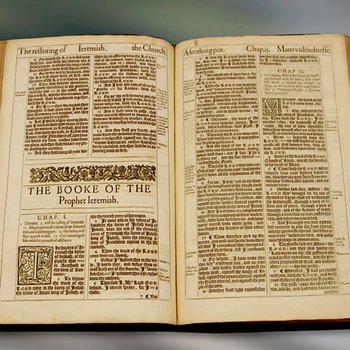King James Bible: The Project
The King James Version of the Bible was not the first English language version of the Bible, but the culmination of extensive translation activity (some illegal!) in the 1500s. This began with the work of William Tyndale and the printing of the first English New Testament in 1526. Following a tumultuous 75 years, King James I came to power in 1603, unifying a divided England. Three main English Bibles were in use: the Bishops’ Bible (Church of England), the Geneva Bible (Protestants), and the Rheims New Testament (Roman Catholic Church), causing much confusion and dissension. To settle disagreements over reforms in the Church of England and respond to pressure from the Puritans, King James in 1604 approved a new translation of the Bible, primarily because he knew that it would reinforce his image as a political and spiritual leader. He appointed six committees, totaling 54 scholars, to prepare the new translation, using previous English Bible translation work, and using the best Hebrew, Greek, and Latin texts and manuscripts. The completed King James Version was first published in 1611. These first editions were large pulpit Bibles (folios) to be read in churches, but were followed within a year by the printing of smaller versions (quartos) for personal use. Though slow to be adopted in the English-speaking world and to replace the more popular Geneva Bible, from the mid-1600s to the late 20th century, the King James Version was THE Bible of the English-speaking church. Though many recent modern translations have gained in popularity at the expense of the KJV, it remains the standard of measure for all new translations, and it still stands as the outstanding masterpiece of the English language.


